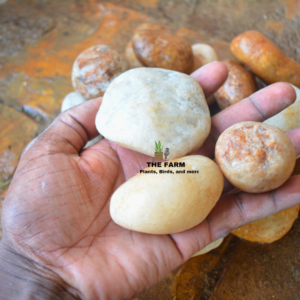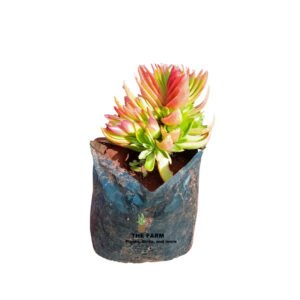Succulent Plants in Kenya
The Perfect Addition to Your Kenyan Garden
- Succulent plants have captured the hearts of gardening enthusiasts in Kenya, thanks to their unique beauty, resilience, and low-maintenance needs. With their thick, fleshy leaves that store water, succulents are naturally drought-resistant, making them ideal for Kenya’s diverse climate. From Aloe Vera and Echeveria to Jade Plants and Cacti, these versatile plants come in a variety of shapes, sizes, and colors, making them an excellent choice for both indoor and outdoor gardening.
Whether you’re an experienced gardener or just starting out, succulents are perfect for adding a touch of greenery to any space. Explore this page to discover the many benefits of succulent plants, how to care for them, and the best areas to place them for maximum impact!
8 Benefits of Succulent Plants
- Low Maintenance
Succulents require minimal watering and care, making them ideal for busy individuals or those new to gardening.
- Air Purification
Many succulents, like Aloe Vera and Snake Plants, help purify the air by removing toxins and increasing oxygen levels, improving indoor air quality.
- Aesthetic Appeal
With their unique shapes, textures, and colors, succulents add a stylish and contemporary touch to any home or garden.
- Improves Focus and Productivity
Studies show that having plants like succulents in your workspace can boost concentration, creativity, and productivity.
- Natural Humidifiers
Succulents release moisture into the air, which can help to improve humidity levels in dry environments, particularly in air-conditioned homes.
- Therapeutic Benefits
Tending to plants like succulents can reduce stress and provide a sense of calm and relaxation.
- Medicinal Uses
Certain succulents, like Aloe Vera, have medicinal properties and can be used to treat skin conditions, burns, and cuts.
- Eco-Friendly Decoration
Unlike cut flowers that wilt and die, succulents are long-lasting, sustainable, and environmentally friendly decorative options.
How to Care for Succulent Plants
To keep your succulents healthy and thriving in Kenya, follow these care guidelines
- Nutrition: Feed succulents with a balanced, diluted fertilizer once a month during the growing season (spring and summer). Avoid fertilizing during the dormant period (fall and winter).
- Pruning: Remove dead or damaged leaves to promote new growth. Pruning also helps maintain the plant’s shape.
- Pest Control: Check for pests like aphids, mealybugs, and spider mites. Use neem oil or insecticidal soap to treat infestations.
- Climate: Succulents thrive in warm, dry conditions. They prefer temperatures between 15-30°C. Avoid placing them in freezing or extremely hot environments.
- Soil: Use well-draining soil, such as cactus or succulent mix, to prevent root rot. Adding sand or perlite can improve drainage.
- Watering: Water succulents sparingly. Allow the soil to dry completely between watering sessions. Overwatering can cause the roots to rot.
Ideal Areas to Place Succulent Plants
Office Desk
Succulents make excellent desk companions, adding a touch of greenery and creating a calming work environment. Their low maintenance needs are perfect for busy workspaces.
Windowsills
Place succulents on windowsills where they can receive bright, indirect sunlight. This spot allows them to get the light they need while enhancing the aesthetics of your space.
Coffee Tables
Displaying succulents on coffee tables brings a natural element into your living room. Their compact size makes them a great fit for small spaces.
Bookshelves
Adding succulents to bookshelves creates a visually appealing contrast with books and other décor items. Their unique shapes and textures can serve as stylish accents.
Entryway
Positioning succulents in your entryway can create a welcoming atmosphere for guests. Their low light tolerance means they can thrive even in less sunny spots.
Bathroom
Succulents can thrive in the humid conditions of a bathroom. Place them on shelves or countertops to add a touch of nature to your daily routine.
Kitchen Counter
A succulent on the kitchen counter can add a refreshing touch to your cooking space while being easy to care for and maintain.
Types of Planters for Succulents
Clay Pots
- Description: Classic and rustic, clay pots are made from unglazed clay.
- Pros: Excellent drainage due to their porous nature, helping to prevent root rot. They are also relatively inexpensive.
- Cons: Can dry out quickly, requiring more frequent watering. May need a saucer to catch excess water.
Ceramic Pots
- Description: Glazed or unglazed ceramic pots offer a stylish and durable option.
- Pros: Available in various colors and designs to match your décor. Glazed ceramic pots retain moisture better, reducing the frequency of watering.
- Cons: Heavier than other options and can be more expensive. Ensure they have drainage holes or add them if necessary.
Plastic Pots
- Description: Lightweight and versatile, plastic pots come in a wide range of styles and colors.
- Pros: Affordable, durable, and easy to move. Often come with built-in drainage options.
- Cons: May not have the same aesthetic appeal as ceramic or terracotta pots. Can degrade over time with exposure to sunlight.
Fiberglass Planters
- Description: Made from a composite of glass fibers and resin, fiberglass planters offer a modern look.
- Pros: Lightweight, highly durable, and available in various finishes. Provides good insulation and often includes drainage features.
- Cons: Can be more expensive and may require additional drainage modifications if not pre-equipped.
Hanging Planters
- Description: Planters designed to be suspended from hooks or brackets.
- Pros: Ideal for saving space and adding vertical interest. Great for showcasing trailing succulents.
- Cons: Requires secure installation and can be challenging to water without removing the planter.
Concrete Planters
- Description: Sturdy and minimalist, concrete planters offer a contemporary look.
- Pros: Durable and heavy, making them stable and resistant to tipping. Provides excellent insulation.
- Cons: Can be heavy and may absorb water, potentially affecting soil moisture levels.
-
6-Inch Plastic Hanging Flower Pots
0 out of 5KSh 899Original price was: KSh 899.KSh 649Current price is: KSh 649. -
8-Inch Hanging Flower Pots
0 out of 5KSh 1,599Original price was: KSh 1,599.KSh 1,099Current price is: KSh 1,099. -
Blue-Black Pebble Stones per kg
0 out of 5KSh 500Original price was: KSh 500.KSh 180Current price is: KSh 180. -
Modern Square Kenpoly planter -NO.1
0 out of 5KSh 199Original price was: KSh 199.KSh 149Current price is: KSh 149. -
Round Pebble Stones per kg
0 out of 5KSh 650Original price was: KSh 650.KSh 200Current price is: KSh 200. -
Sphere Fiber Glass Planters -10x13cm
0 out of 5KSh 4,999Original price was: KSh 4,999.KSh 3,499Current price is: KSh 3,499.
Seedlings and Accessories
Explore a variety of succulent seedlings and planting accessories, like pebbles, on thefarm.co.ke. Choose from a range of seedlings, from Aloe Vera to Jade Plant, to start your succulent journey. Complement your plants with decorative pebbles and stylish planters to create a vibrant and lively space.
Where to Buy Succulent Plants in Kenya
Showing 1–6 of 7 results
-
Black Gem Succulent Plants
0 out of 5KSh 1,250Original price was: KSh 1,250.KSh 580Current price is: KSh 580.Select options This product has multiple variants. The options may be chosen on the product page Buy via WhatsApp -
Echeveria Imbricata Succulent
KSh 599 – KSh 1,2990 out of 5Select options This product has multiple variants. The options may be chosen on the product page Buy via WhatsApp -
Echeveria Succulents
KSh 1,8990 out of 5Select options This product has multiple variants. The options may be chosen on the product page Buy via WhatsApp -
Gasteraloe Succulent plants
KSh 2,8990 out of 5Select options This product has multiple variants. The options may be chosen on the product page Buy via WhatsApp -
Kalanchoe Luciae Succulent Flap Jack Plant
0 out of 5KSh 1,995Original price was: KSh 1,995.KSh 1,299Current price is: KSh 1,299. -
Red Pagoda Succulent
0 out of 5KSh 1,299Original price was: KSh 1,299.KSh 799Current price is: KSh 799.
End of content
End of content
- Frequently Asked Questions
Succulents need about 4-6 hours of indirect sunlight daily. In Kenya, it’s best to place them where they receive morning sunlight and are shaded during the intense afternoon sun to prevent leaf burn.
Yes, but they need proper drainage to prevent root rot. Place outdoor succulents in planters with drainage holes or raised beds. Avoid overwatering, as succulents thrive in drier conditions.
Succulents need well-draining soil. A cactus or succulent mix is ideal. If using garden soil, add sand or perlite to improve drainage and prevent waterlogging.
Water only when the soil is completely dry. In Kenya’s warm climate, this may mean watering once every 1-2 weeks, depending on the season and indoor/outdoor placement.
You can purchase a variety of succulents, planters, and gardening accessories from thefarm.co.ke, along with other local nurseries and garden centers.
Common pests include mealybugs, aphids, and spider mites. Check your plants regularly and treat them with organic insecticides or neem oil if you notice any pests.
Yes, but if your tap water is very hard or chlorinated, consider using filtered or rainwater to avoid potential damage to your plants over time.
At The Farm, we offer beautifully pre-potted succulent plants that are perfect for enhancing your home or office décor. Our succulents come ready to display, so all you need to do is enjoy their natural beauty and provide a little care to keep them thriving.



















